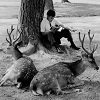Ec(h)o-texts: Mangroves and the rhizomatic city
DOI:
https://doi.org/10.51777/relief12376Keywords:
Patrick Chamoiseau, René Girard, cities, mangroves, volcanic stonesAbstract
The city is at the heart of Patrick Chamoiseau’s third novel Texaco (1992) in a very specific way: the wasteland bordering Fort-de-France, called Texaco, which was built after the volcanic eruption that destroyed Saint-Pierre, is being described as an “urban mangrove” rather than as a “slum”. Destined for destruction, the area is being salvaged thanks to the “divine” intervention of the urban planner, first welcomed by stone-throws before turning into a Christ figure – one of the many biblical references woven into Texaco’s structure, undoubtedly in reminiscence of René Girard’s ideas on violence and the sacred. More recently, in 2012, Chamoiseau initiated a project of urban renovation aiming at reconstructing the old capital of Saint-Pierre on a poetic base. In between these two urban enterprises, one fictional, the other anchored in the “reel” world, Chamoiseau has produced a literary opus in which the city seems to have disappeared and nature has regained the upperhand. However, in Chamoiseau’s latest fiction, Matière de l’absence (2016) a new imaginary construction comes to the fore, made of volcanic stones and pre-Columbian ruins, a mineral world which echoes Édouard Glissant’s notion of “Tout-monde”: one in which Girard’s theory does no longer appear, as a more pacified vision of the world is being presented.

Downloads
Published
Issue
Section
License
Copyright (c) 2022 Jean-Louis Cornille

This work is licensed under a Creative Commons Attribution 4.0 International License.
Tous les articles dans RELIEF sont publiés en libre accès sous la licence Creative Commons Attribution 4.0 International License (CC-BY 4.0). Sous ce régime les auteurs conservent les droits d'auteur mais ils consentent à toute sorte d'utilisation de leur texte pourvu qu'il soit correctement cité.


